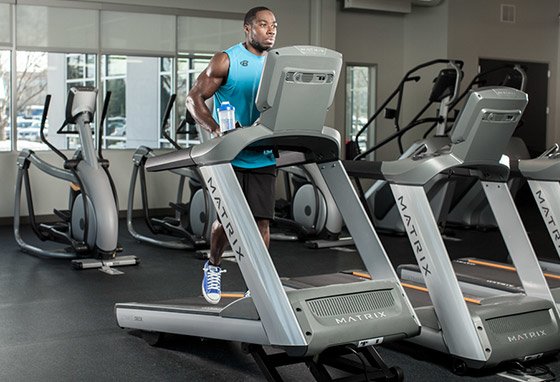Find yourself rushed for a workout? Love hitting the weights but don't have time for conditioning? High-intensity interval training (HIIT) could be the solution to your workout woes, allowing for greater calorie burn and cardiovascular training in a shorter amount of time. But with volumes of information on HIIT, starting from scratch can seem like a daunting task. So we gathered six of the best tips to start off HIIT strong.
Tip 1. Start Slow and Build Up
High-intensity intervals are effective at increasing metabolism and burning fat, but they can be tough on the cardiovascular and nervous systems. Age, fitness level, and even gender can have an impact on how quickly we recover.
If you are new to intervals, start with one or two high-intensity sessions per week to avoid overtraining. This will allow the body enough time to replenish its energy stores while adapting to the increased workload.

Tip 2. Mix It into What You Love
Research indicates interval training can give the metabolism a boost in half the time of steady-state cardio. But 15 minutes alone doesn't make a well-rounded fitness routine. Use intervals to supplement the workouts you already know and love: lifting, yoga, and more traditional endurance training. This will give the body time to replenish energy stores—especially glycogen—and avoid mental fatigue.
Tip 3. Pick a Plan
When it comes to intervals, most of us can use a little help when it comes to figuring out a program. Try an established interval training regimen like Tabata Protocol or The Little Method to maximize your workout's effectiveness and the ensuing metabolism spike.
There are also many great trainer-tested and runner-approved programs designed specifically for beginners. Sticking to a pre-written plan—especially for the first few weeks or months of interval training—makes tracking progress a breeze.

Tip 4. Keep on the Clock
Use a stopwatch or interval-based smartphone app to push through and get the most out of each session, whether running, swimming, or completing circuits in the weight room. When performing high-intensity sprints, it can be tempting to go until we feel that familiar burn—and then stop to catch our breath. But humans can be poor judges of time when fatigued, and without a clock to keep us honest, hard intervals can quickly turn into stopping too soon.
Tip 5. Go Hands-Free on the Treadmill
Using the handrails for support can significantly decrease the body's oxygen use—and thus the workout's effectiveness. If you have trouble staying on the belt, reduce the speed and gradually build back up over the next few sessions.
Tip 6. Make Small Changes for a Big Challenge
Do you have a few months of interval training under your belt? A few small tweaks can add a whole new world of challenges. Increase the incline on a treadmill, or wear a weighted vest while running or lifting to boost the effectiveness of intervals for a seasoned pro. Increasing ratio of work-to-rest in interval training is also a great way to build endurance, even in workouts that can last 25 minutes.

References
- Boutcher, S.H. High-intensity intermittent exercise and fat loss. School of Medical Sciences, Faculty of Medicine, University of New South Wales, Sydney, Australia. Journal of Obesity. 2011; (epub).
- Tabata, I., Irisawa, K., Kouzaki, M., et al. Metabolic profile of high intensity intermittent exercises. Department of Physiology and Biomechanics, National Institute of Fitness and Sports, Kanoya City, Japan. Medicine & Science in Sports & Exercise 1997 Mar;29(3):390-5.
- Laurent, CM., Green, JM., Bishop, PA., et al. Effect of gender on fatigue and recovery following maximal intensity repeated sprint performance. Department of Kinesiology, St. Ambrose University, Davenport, IA. The Journal of Sports Medicine and Physical Fitness. 2010 Sep; 50(3):243-53.
- Burgomaster, K.A., Howarth, K.R., Phillips, S.M., et al. Similar metabolic adaptations during exercise after low volume sprint interval and traditional endurance training in humans. Exercise Metabolism Research Group, Department of Kinesiology, McMaster University, Hamilton, Ontario, Canada. Journal of Physiology 2008 Jan 1;586(1):151-60.
- Jacobs, P.L., Nash, M.S., Rusinowski, J.W. Circuit training provides cardiorespiratory and strength benefits in persons with paraplegia. Department of Neurological Surgery, University of Miami School of Medicine, Miami, FL. Medicine and Science in Sports and Exercise, 2001 May;33(5):711-7.
- Slawinski J, Dorel S, Hug F, et al. Elite long sprint running: a comparison between incline and level training sessions. Laboratory of Biomechanics and Physiology, French National Institute of Sports, Paris, France. Medical Science in Sports and Exercise, 2008 Jun;40(6):1155-62.
- Berling J, Foster C, Gibson M, Doberstein S, et al. The effect of handrail support on oxygen uptake during steady-state treadmill exercise. Department of Exercise and Sport Science, University of Wisconsin, La Crosse, WI. Journal of Cardiopulmonary Rehabilitation, 2006 Nov-Dec;26(6):391-4.

